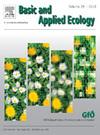Challenges and opportunities when studying movement ecology in science and practical conservation
IF 3.5
2区 环境科学与生态学
Q2 ECOLOGY
引用次数: 0
Abstract
Movement is a key mechanism influencing biodiversity patterns and ecosystem processes. Movement ecology aims to understand the causal relationships between environmental conditions, animal movements, interactions and coexistence of species, as well as effects of movement patterns on ecosystem processes. In contrast, practical conservation primarily aims to understand organisms' movements to improve species management, protection, legal monitoring or risk assessment, and species-habitat interactions. Despite the many studies of movement ecology in basic and applied sciences as well as in practical conservation in terrestrial ecosystems, knowledge gain and transfer between disciplines are limited. Better integration and linking of both disciplines would result in diverse science-practice synergies, but these are currently constrained by numerous challenges that need to be overcome. From a scientific perspective, knowledge gain from practice is limited by a multitude of case studies with limited spatial and temporal resolution. This can be overcome by improving access and combining the diversity of data for a research area that often deals with small sample sizes. From a practical perspective, the movement ecology framework, which is often dedicated to basic research, as well as the access and language barriers to scientific publications, limit the application of scientific results. Here movement ecologists should be encouraged to consider conservation issues more frequently in addition to basic research. The transfer of scientific results could be improved by scientists providing sufficient details for practitioners to extract relevant information and publish at least an open-access abstract in local language with clear management recommendations. Further, the use of open-access repositories allows both, scientists and practitioners an overview of the multitude of studies and helps to share data in order to derive general conclusions. Challenges impacting science and practice can be conceptual, organisational and technical in nature. Such constraints can be overcome, for example, by providing verified trapping protocols, using recent technological developments and analytical methods combined with trainings on these state-of-the-art tracking and analysing tools. In particular, collaborative project planning between scientists and practitioners can help to improve the sampling design of applied studies and broaden the data base for science in order to significantly advance the movement ecology framework and gain comprehensive knowledge for practical conservation.
在科学和实际保护中研究运动生态时面临的挑战和机遇
运动是影响生物多样性模式和生态系统过程的关键机制。运动生态学旨在了解环境条件、动物运动、物种相互作用和共存之间的因果关系,以及运动模式对生态系统过程的影响。相比之下,实际保护的主要目的是了解生物的运动,以改进物种管理、保护、法律监测或风险评估,以及物种与栖息地之间的相互作用。尽管在陆地生态系统的基础科学、应用科学和实际保护中对运动生态学进行了大量研究,但学科间的知识获取和转移仍然有限。更好地整合和联系这两个学科将产生多种多样的科学与实践协同作用,但目前这受到许多挑战的制约,需要加以克服。从科学的角度来看,从实践中获取的知识受到空间和时间分辨率有限的大量案例研究的限制。要解决这一问题,可以通过改善数据的获取途径并将数据的多样性结合起来,而这一研究领域往往需要处理较小的样本量。从实践的角度来看,运动生态学框架通常致力于基础研究,科学出版物的获取和语言障碍也限制了科学成果的应用。在此,应鼓励运动生态学家在基础研究之外更多考虑保护问题。如果科学家能够提供足够的详细信息,使从业人员能够提取相关信息,并至少以当地语言发表可公开获取的摘要,同时提出明确的管理建议,则可提高科学成果的转化率。此外,使用开放式资料库可使科学家和从业人员对众多研究有一个总体了解,并有助于共享数据,从而得出一般性结论。影响科学和实践的挑战可能是概念性、组织性和技术性的。例如,可以通过提供经过验证的诱捕规程,利用最新的技术发展和分析方法,并结合对这些最先进的跟踪和分析工具的培训,来克服这些制约因素。特别是,科学家和从业人员之间的合作项目规划有助于改进应用研究的取样设计,扩大科学数据基础,从而大大推进运动生态学框架,并获得实际保护所需的全面知识。
本文章由计算机程序翻译,如有差异,请以英文原文为准。
求助全文
约1分钟内获得全文
求助全文
来源期刊

Basic and Applied Ecology
环境科学-生态学
CiteScore
6.90
自引率
5.30%
发文量
103
审稿时长
10.6 weeks
期刊介绍:
Basic and Applied Ecology provides a forum in which significant advances and ideas can be rapidly communicated to a wide audience. Basic and Applied Ecology publishes original contributions, perspectives and reviews from all areas of basic and applied ecology. Ecologists from all countries are invited to publish ecological research of international interest in its pages. There is no bias with regard to taxon or geographical area.
 求助内容:
求助内容: 应助结果提醒方式:
应助结果提醒方式:


